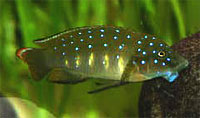Unusual Freshwater Species
Chris Deer
|

The Coral Red Pencilfish
(Nannostomus mortenthaleri) |
This is considered one of the most beautiful and hard to obtain pencilfish. Though they are not as vivid as the adult male pictured here, once they become established and comfortable, the males are fire red just as the one pictured here. The females are duller in color though still beautiful. The Coral Red Pencilfish should only be housed with peaceful smaller species like cardinal tetras, |
rummynose tetras, neon tetras, discus and similar species. These fish acclimate to a pH of 6.0-7.4, soft water low in organics (you must keep up with your partial water changes) with a steady temperature ranging from 75-84 degrees. Though these fish will eat flake foods, for best color and health, supplemental foods like bloodworms and brine shrimp are recommended. If you�re a fish geek, you�ve got to add these to your community aquarium collection or just set up a small aquarium to house these beauties!!
|
| This is one of the most unusual of the Eartheater group. They are referred to as eartheaters due to their constant sifting of the substrate filtering out food items. Adult sizes (about 6�-7�) of this species are rare and they are completely spectacular. Displaying the massive humped head and striking markings these are a rarity for the cichlid collector that |

The Balzani Eartheater
(Gymnogeophagus balzani) |
houses larger but mild-mannered species. These fish should NOT be kept with aggressive large cichlids instead they should be housed with species like uaru, gouramis, severums, festivums, silver dollars, bala sharks and similar medium aggressive to passive species. Balzani eartheaters require soft water (GH of 10 or less) with a pH range of 6.5-7.5. Supposedly this fish will even tolerate water temperatures of 70 degrees but 75-80 degrees is recommended. Like others in the eartheater group, these fish are mouth-brooders. The female drops the eggs, the male then fertilizes them, then the female takes the eggs (up to 500) into her mouth where she will hold them without eating until the eggs have hatched and the fry are large enough to feed on their own.
|

The African Goby Cichlid
(Eretmodus cyanostictus)
|
This is one of the coolest fish from the shoreline of Lake Tanganyika in Africa. Though they are a cichlid, they are often referred to as goby cichlids due to their lack of an active swim bladder. This means that when these fish are not swimming, they sink quickly to the bottom of the aquarium where they perch on rockwork. These fish are herbivores that scrape algae off rockwork with their large teeth. We suggest using frozen vegetable-based foods in conjunction with spirulina flake foods. These fish should NEVER be |
fed foods like bloodworms, brine shrimp or mysis shrimp as it will cause them to develop a bloating condition and die. Like other species from Lake Tanganyika, the Eretmodus prefers hard alkaline water with a pH of 8.0-9.0. The water they come from is similar to the surfline of the ocean with strong currents rich in oxygen.
|
| The aquarium should be equipped with strong aeration with the use of airstones or aerating power heads. Another cool fact about this super cool fish is that they are bi-parental. When the female lays the eggs, the male fertilizes them as the female quickly puts the eggs into her mouth. She |
 |
will hold them there for about 12 days. During this time, the eggs will hatch into tiny larval fry while still in here mouth. Then she will transfer the fry into the males mouth where he will hold them for about 10 more days! By this time, the fry can feed on their own and he will release them and the parents no longer give them care. They lay only 10-20 eggs per spawning. It is said that these fish pair for life.
|
|










